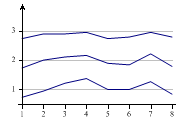| Professional charting tools for .Net developers |
Introducing SharpPlot
Your First Chart
Recent Updates
Sample Charts
Tutorials
General Tutorials
Chart Tutorials
SharpPlot Class
Properties
Structures
Enumerations
Style examples
Glossaries
Active Charts
VectorMath Class
DBUtil Class
Get SharpPlot
Download SharpPlot
Buying SharpPlot
SharpPlot Support
Upgrading from GraPL
Release notes
Reference > Methods > DrawTraceChart Method
SharpPlot.DrawTraceChart Method
Seismometer-style chart with multiple parallel traces.
Example
sp.SetMargins(12,12,18,4); tracedata = new int[][]{new int[]{0,4,9,12,5,5,10,2},new int[]{0,5,7,8,3,2,9,1}, new int[]{0,3,3,4,0,1,4,1}}; sp.YAxisStyle = YAxisStyles.GridLines|YAxisStyles.ArrowedAxis; sp.IAxisStyle = IAxisStyles.PlainAxis; sp.DrawTraceChart(tracedata);
The short tutorial shows a few of the possibilities and some sample code.
Overloads
- public void DrawTraceChart(int[][] data);
- public void DrawTraceChart(double[][] data);
- public void DrawTraceChart(int[][] data,int[] xValues);
- public void DrawTraceChart(double[][] data,int[] xValues);
- public void DrawTraceChart(int[][] data,double[] xValues);
- public void DrawTraceChart(double[][] data,double[] xValues);
Description
Trace charts are a slightly specialist style of plot, originally designed for data from devices like seismographs and EEGs where multiple pens trace out (almost) parallel lines. Each pen is allocated a tickmark on the Y-axis and then an ‘inner axis’ is created for it (naturally these inner axes are all scaled identically). The trace may be filled (a style of chart often used to show inventories in a tank-farm at an oil refinery) or it may be drawn symmetrically to create a style called a ‘Kite diagram’ which often appears in botanical studies of vegetation coverage.
See also ...
Trace charts for Multiple Series | SharpPlot Members | TraceChartStyle Property
